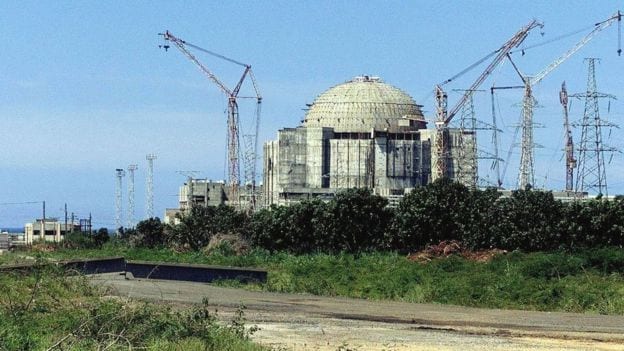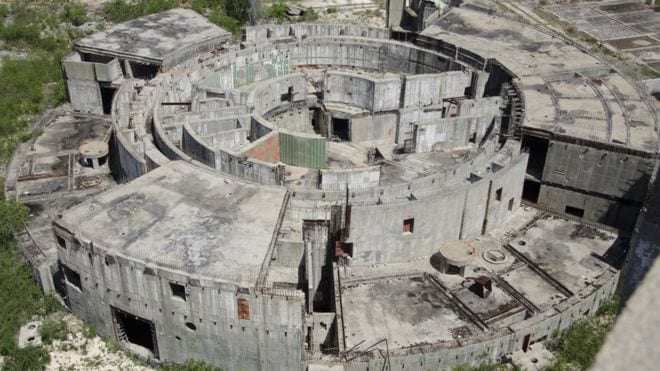Chernobyl in Cuba, Brewing against Oblivion
By Vicente Morin Aguado and Maribella Morales Montoya

HAVANA TIMES – Valery Legasov, Chernobyl’s leading scientist, faced death with these words: “What is the cost of lies? It’s not that we’ll mistake them for the truth. The real danger is that if we hear enough lies, then we no longer recognize the truth at all.” The question includes us because during that disastrous decade, marked by the end of totalitarian socialism in Europe, among great jubilation and sadness, Cuba had its own nuclear miscarriage.
Cubans’ growing acceptance of the HBO series was a healthy surprise. At least we have been able to remember Juragua in Cienfuegos, the Electronuclear Plant and Nuclear City, in recent weeks. The latest news is alarming, the cement block that should have stored the first of the two pressurized water reactors, became the National Toxic Waste Confinement, by decree.
Due to the whims of History, we managed to escape danger, only to face new dangers a quarter of a century later.
From 1982 until 1992, when energies were squandered to build what was called here the Project of the Century, public opinion took on the megaproject pushed by Fidel Castro, without criticism. His son, Fidel Castro Diaz-Balart, a nuclear physicist trained in the Soviet Union, took the reins of the country’s nuclear energy program.

Inherent to socialism until today, the trend of relaxing labor attitudes seems to be reaching extreme heights in our country. It’s been proven that the Comandante’s proverbial energy wasn’t enough to do away with the pseudo-labor habits growing among Cubans.
The Juragua project was no exception. Let’s summarize some testimonies taken from archives on a TV channel that used to broadcast in Cienfuegos during the second half of the 1980s:
Technician No. 1. “Metallography tests produced cracks in a turbine’s components, as well as on the bolt of the generator’s base #4, which we repaired here because it arrived with factory defects.”
Technician No. 2. “The pivoting arm of a lever for the feedback system also had defects, on the side where there is a hub. This mechanism regulates the entry of steam into the turbines and its electrical power.”
Technician No. 3. “Most of these machines, which are to regulate processes, needed adjustments here, and even repairs; many of them were missing pieces, for example, a 30 hundredths ring from one of the valves, which was requested, the Soviets accepting its replacement.”

These weren’t isolated incidents. In the 2015 movie “La Obra del Siglo”, a coproduction between M-Appeal and the Cuban Film Institute, the following fragment from an assessment report was reproduced:
“The number of adjustments and repairs in situ, with the consequent additional pressure of metals, as well as other defects detected in the system, weighed upon the reliability of the equipment and could cause unpredictable results in their optimum combination.”
The disastrous shadow of Chernobyl crossed Fidel Castro’s path, a premonition of an unexpected end for Vladimir Ilich Lenin’s revolution, whose name was used to identify the contingent of workers in Juragua, Cienfuegos.
In September 1992, the Comandante came when it was pouring rain to tell the staff, in person, that the Project of the Century would be paralyzed indefinitely. The builders refused to leave the place that held so many promises for them. Virgen Martinez was one of the first families to settle there, along with her husband and her children. Now, they don’t want to leave their nuclear city, the proud Cuban Pripyat:
“We have been in survival mode since 1992, we have learned to face the shock. First, it was transport, we had guaguas (buses), one after the other, going to Cienfuegos, Havana, anywhere. A lot more supplies than anywhere else, all kinds of canned goods, bags of fresh meat, a double ration of milk for people working with chemicals, and apartments, having a home has always been difficult here in Cuba.”
HT asks: What does survival mode mean?
“Let me tell you, it means making the most of everything, rearing pigs, we have a lot of pens, the gates are made of pipes taken from the abandoned buildings; then you have the Flintstones, who smash up concrete blocks and then sell the rebar. There are people who have built their homes with materials from the plant. Let’s go to the beach, and you can see fishermen on the reef. The polyclinic, post office and bank are still open; the city is alive in spite of everything, but you can feel the emptiness, before people used to be everywhere at all hours of the day, a constant buzz, a lost joy. Now, streets are deserted at night…”
We showed Virgen and her daughter Raiza scenes from the Cuban movie La Obra del Siglo, the dome of the building that would hold one of the reactors appears on screen:
“Look, you can still see it just like that if you go there today, that crane still exists, we don’t know what it’s doing there.”
Now, the military occupies the area, fencing off the abandoned buildings. There are plenty of bold people who sneak in looking for treasures: “People say that there is silver, titanium, valuable metals inside. A young man died trying to discover these alleged treasures,” Virgen tells us.
The decision to make the most of such a robust building as a dumping ground for toxic waste, appeared on Cubadebate’s website, the Party’s leading online newspaper. This matter, which has received minimal coverage in the Cuban media, doesn’t seem to concern survivors of the former nuclear city.
Only some readers left comments on the website, but it’s worth summarizing such an expressive exchange, explained by pseudonyms:
M&m: Ha! and then people in Cienfuegos will create their own Greenpeace, and block highways and railway tracks, so that they don’t take all of Cuba’s toxic grime to their clean province. Carlos said: This is banned in Cuba. El profesor wrote: It isn’t a problem of this being banned or not. The problem is that it isn’t necessary here in Cuba. We are sure that they will take all of the safety measures needed. Carlos said: Of course, nothing is necessary in Cuba… Manolo said: Toxic waste will go there and THAT’S THAT. There is no discussion. Gutierrez said: GO ON, I DARE YOU!
The dark cloud of penetrating ionizing radiation continues to hover above our heads.
—–
Read this related story: Chernobyls Clouds Still Hover over Cuba
(Click on an image to display the gallery.)
[edge_gallery id=”154956″]
Vicente Morin and Maribella Morales: [email protected]






Virtually everything in Cuba is a “state secret”, until its rulers determine otherwise.
Dark cloud is:
The state does not offer information on toxic waste, the comments prove it.
Decree determines something especially sensitive for the population.
Security is questioned by constructive practice.
There is no social control over megaprojects. In the end, Cuba has other options to solve the problem of electricity generation.
The reader must seek the meaning, the background of the written.
Thanks for your wonderful, clear response to a bad article and lack of knowledge. ?
The right email is [email protected] for Vicente and Maribella, the autrhors of this article.
A couple of items missing from this story that may be misleading for those who don’t study history:
1) The plant in Juragua included substantial safety upgrades over the Chernobyl design. Calling it “Chernobyl in Cuba” represents the logic fallacy “Appeal to the Emotions”. The Cubans participated in the Siemans construction of a plant in Finland designed to avoid the disaster of Chernobyl.
2) It is significant to note that nuclear fuel was never delivered to Cuba (Nuclear Safety: Concerns with the Nuclear Power Reactors in Cuba. (GAO/T-RCED-92-262, September 1992)).
While the term “toxic waste” may be correct, one should not infer from this that a Three-mile Island, Chernobyl or Fukushima type of contamination was ever possible. This should have been clearly stated to avoid unnecessary fears.
The final statement, “The dark cloud of penetrating ionizing radiation continues to hover above our heads.” is without grounds. With no fissible material there can be no “dark clouds of radiation”.
Thank you for your article.
That is not Valery Legasov in that picture. It is the actor who played him in the t.v. series,Chernobyl. The actors name is Jared Harris.